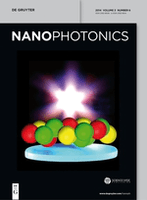
Nanophotonics
Scope & Guideline
Illuminating the Future of Light Manipulation
Introduction
Aims and Scopes
- Nanophotonic Materials and Structures:
Research on various materials such as metals, dielectrics, and 2D materials that exhibit unique optical properties at the nanoscale, including metamaterials and photonic crystals. - Plasmonics and Surface Plasmon Polaritons:
Exploration of surface plasmons and their interactions with light, particularly in applications like sensing, imaging, and energy harvesting. - Quantum Nanophotonics:
Studies focusing on the quantum properties of light and matter interactions, including quantum dots, single-photon sources, and quantum information processing. - Integrated Photonics:
Development of photonic circuits that integrate various optical components on a single chip, enabling applications in communication, sensing, and computing. - Nonlinear Nanophotonics:
Investigation of nonlinear optical effects in nanostructures, leading to applications in frequency conversion, optical switching, and signal processing. - Biosensing and Biomedical Applications:
Utilization of nanophotonic techniques for bioanalytical applications, including the detection of biomolecules and imaging of biological systems. - Optoelectronics and Photonic Devices:
Research on the design and fabrication of devices such as lasers, modulators, and detectors that leverage nanophotonic principles. - Optical Metasurfaces:
Innovative studies on metasurfaces that manipulate light at subwavelength scales for applications in imaging, sensing, and holography.
Trending and Emerging
- AI and Machine Learning in Nanophotonics:
Recent papers emphasize the integration of artificial intelligence and machine learning algorithms in the design and optimization of nanophotonic devices, indicating a trend towards data-driven approaches. - Quantum Photonics and Quantum Information:
A significant increase in studies related to quantum photonics, including entangled states, quantum communication, and quantum sensing, highlights the growing interest in harnessing quantum phenomena. - Dynamic and Reconfigurable Metasurfaces:
Research on dynamically tunable and reconfigurable metasurfaces is on the rise, showcasing the potential for real-time control of optical properties for various applications. - Hybrid Nanophotonic Systems:
Emerging studies focus on hybrid systems that combine different materials and functionalities, such as integrating plasmonics with semiconductor devices for enhanced performance. - Thermal Management and Energy Harvesting:
There is a growing emphasis on the use of nanophotonic structures for thermal management and energy harvesting applications, reflecting the need for sustainable technologies. - Nanophotonic Sensing Technologies:
An increasing number of publications highlight advancements in nanophotonic sensing technologies, particularly for biomedical and environmental applications, showcasing their practical relevance. - Topological Photonics:
Research on topological phenomena in photonics is gaining momentum, focusing on robust light manipulation and new device concepts based on topological principles.
Declining or Waning
- Classical Photonics:
Research that focuses on traditional photonic principles without the integration of nanotechnology, which seems to be declining as the field moves towards more advanced nanophotonic applications. - Bulk Material Studies:
Studies that primarily focus on bulk materials rather than nanoscale phenomena are less frequently published, as the emphasis shifts towards nanoscale interactions and applications. - Conventional Optical Imaging Techniques:
Traditional imaging methods that do not incorporate advancements in nanophotonics or novel imaging modalities are becoming less prevalent in favor of more sophisticated techniques. - Single Photon Sources in Bulk Materials:
Research on single-photon sources that do not leverage nanostructuring or advanced fabrication techniques is waning, as the field pushes towards integrating quantum optics with nanophotonics.
Similar Journals
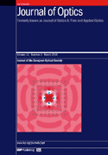
Journal of Optics
Pioneering Research in Atomic and Molecular OpticsThe Journal of Optics, published by IOP Publishing Ltd, stands as a pivotal platform for disseminating cutting-edge research in the fields of atomic, molecular physics, and optics as well as electronic, optical, and magnetic materials. With an impact factor reflective of its esteemed position—ranking in the 60th percentile in both relevant Scopus categories—this journal, boasting an ISSN of 2040-8978 and an E-ISSN of 2040-8986, is uniquely positioned to foster innovation and collaboration among researchers, professionals, and students worldwide. Located in the United Kingdom and operational since 2010, the journal embraces an open access model, promoting maximal reach and engagement with the latest discoveries that shape the future of optics. As it continues to evolve through its converged years up to 2024, the Journal of Optics remains a critical resource for those seeking to advance their knowledge and influence in this dynamic field.
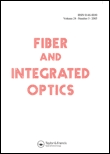
FIBER AND INTEGRATED OPTICS
Exploring the Nexus of Light and TechnologyFIBER AND INTEGRATED OPTICS is a prominent academic journal published by TAYLOR & FRANCIS INC, focusing on the cutting-edge domains of optical and fiber technologies. Since its inception in 1977, the journal has journeyed through expansive developments in the fields of Atomic and Molecular Physics, as well as Electronic, Optical, and Magnetic Materials, boasting a converged publication history extending to 2024. With a solid reputation reflected in its Q3 rankings in both aforementioned categories, FIBER AND INTEGRATED OPTICS serves as an essential platform for researchers, professionals, and students to disseminate and explore innovative findings and methodologies. Although currently not offering Open Access, its scholarly contributions remain invaluable, fostering a deeper understanding and advancements in fiber optic applications and integrated optical systems. Situated in the United Kingdom, the journal continues to attract a diverse global audience, solidifying its significance in contemporary scientific discourse.

Photonics
Pioneering Discoveries in Atomic and Molecular PhysicsPhotonics, an esteemed journal published by MDPI, is a leading platform for researchers in the fields of atomic and molecular physics, optics, and instrumentation. Since its inception in 2014, the journal has fostered open access to cutting-edge research, facilitating knowledge dissemination in these dynamic disciplines. With its Q2 ranking in the 2023 Scopus metrics for various categories, including radiology, nuclear medicine, and imaging, Photonics represents a crucial academic resource for professionals and students seeking to advance their understanding and expertise. Located in Basel, Switzerland, the journal plays a pivotal role in bridging theoretical and practical approaches to photonic technologies. Researchers are encouraged to contribute their findings, thereby enriching the journal’s impact and relevance in the global scientific community through collaboration and innovation.
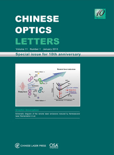
Chinese Optics Letters
Advancing the frontiers of optical research.Chinese Optics Letters is a prestigious academic journal published by Chinese Laser Press, dedicated to advancing the fields of atomic and molecular physics, optics, as well as electrical and electronic engineering. Since its inception in 2003, this journal has become a significant platform for researchers and professionals to disseminate innovative findings and foster collaboration within these rapidly evolving disciplines. With a commendable Q2 ranking in leading categories including Atomic and Molecular Physics and Electronic, Optical and Magnetic Materials, it ranks favorably within the Scopus database, with notable positions in both engineering and materials science sectors. The journal is headquartered in Shanghai, China, and while additional open access options are not specified, it remains a vital resource for those committed to pushing the frontiers of optical research and applications. As we approach 2024, Chinese Optics Letters continues to play an essential role in shaping scholarly discourse and technological advancement in optics.
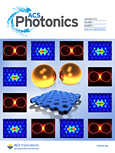
ACS Photonics
Leading the Charge in Photonics ExcellenceACS Photonics, published by the American Chemical Society, is a leading journal dedicated to advancing the interdisciplinary fields of photonics and optics. Since its inception in 2014, the journal has swiftly established itself as a premier platform for the dissemination of groundbreaking research, achieving a distinguished Q1 ranking across several categories including Atomic and Molecular Physics, Biotechnology, Electrical and Electronic Engineering, and Electronic, Optical and Magnetic Materials. With an impressive Scopus Rank and notable percentiles—ranking 19th in Atomic and Molecular Physics and 32nd in Biotechnology—the journal continues to shape the dialogue surrounding innovations in laser technology, optical materials, and biophotonic applications. While the journal does not currently offer open access options, it remains a vital resource for researchers, professionals, and students seeking to explore the cutting-edge developments in this dynamic field. Located in Washington, DC, ACS Photonics is committed to bridging theoretical insights with practical applications, making significant contributions to science and technology.
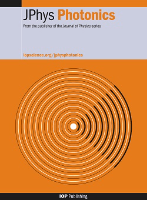
Journal of Physics-Photonics
Connecting Innovations in Physics and PhotonicsJournal of Physics-Photonics, published by IOP Publishing Ltd in the United Kingdom, is an esteemed Open Access journal that has been at the forefront of research in the field of photonics since its inception in 2018. With an impressive portfolio, the journal has achieved Q1 ranking in 2023 across multiple disciplines, including Atomic and Molecular Physics, Electrical and Electronic Engineering, and Electronic, Optical, and Magnetic Materials. This positions it among the leading journals in these areas, reflecting its significant influence and contribution to advancing knowledge and innovation. The journal aims to disseminate high-quality research findings that encompass a wide range of topics in photonics, promoting interdisciplinary approach that fosters collaboration among researchers, professionals, and students. With its commitment to open access, Journal of Physics-Photonics ensures that groundbreaking research is accessible to all, empowering a global audience to engage with and benefit from the latest advancements in photonic technologies.
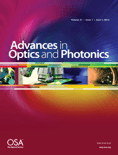
Advances in Optics and Photonics
Connecting Researchers in the Realm of LightAdvances in Optics and Photonics, published by the Optica Publishing Group, stands at the forefront of research dissemination in the fields of Atomic and Molecular Physics and Optics, alongside its prominence in Water Science and Technology. With an impressive Q1 ranking in both categories and a Scopus rank of #2/224, this journal boasts a 99th percentile status, underscoring its significance in the academic community. As a beacon of knowledge since its inception in 2009, the journal is dedicated to featuring cutting-edge research, innovative methodologies, and transformative applications in optics and photonics that can drive advancements across diverse scientific domains. While not an open-access journal, it provides vital insights for researchers, professionals, and students eager to stay updated on emerging trends and breakthroughs. With a convergence period extending to 2024, Advances in Optics and Photonics is positioned as an essential resource for anyone looking to explore the evolving landscape of light-based technologies.

Advanced Photonics Research
Pioneering Research in Photonic FrontiersAdvanced Photonics Research is a leading open-access journal published by WILEY, dedicated to advancing the field of photonics through rigorous research and comprehensive reviews. With its ISSN 2699-9293, the journal aims to disseminate innovative findings in areas such as photonic materials, devices, systems, and applications. Since transitioning to an Open Access model in 2020, it has significantly increased accessibility for researchers, professionals, and students alike, promoting wider dissemination and collaboration within the global photonics community. The journal's commitment to high-quality, peer-reviewed content ensures it remains an essential resource for those seeking to stay at the forefront of photonics research. Positioned to influence both academia and industry, Advanced Photonics Research is an invaluable platform for sharing cutting-edge discoveries that drive the future of technology.

OPTICAL AND QUANTUM ELECTRONICS
Driving Breakthroughs in Quantum TechnologiesOPTICAL AND QUANTUM ELECTRONICS, published by SPRINGER, is a premier journal dedicated to advancing the fields of atomic and molecular physics, optics, and electronic engineering. With an ISSN of 0306-8919 and an E-ISSN of 1572-817X, this journal has established itself as a vital resource for researchers, professionals, and students alike, contributing to the discourse from its inception in 1969 to its continued publications through 2024. It holds impressive rankings in Scopus, placing within the top percentiles for its categories, specifically in the 64th for Electrical and Electronic Engineering and 63rd for Atomic and Molecular Physics. Though it does not currently offer open access options, the journal's robust impact factor reflects its importance within its field, making it an essential reference point for cutting-edge research and developments in materials science and optics. Through its rigorous peer-review process, OPTICAL AND QUANTUM ELECTRONICS remains committed to publishing high-quality, influential studies that push the boundaries of innovation and understanding in these dynamic areas of science.

Laser & Photonics Reviews
Empowering Researchers with Cutting-Edge DiscoveriesLaser & Photonics Reviews is a prestigious academic journal published by WILEY-V C H VERLAG GMBH, based in Germany. Since its inception in 2007, the journal has rapidly established itself as a leading outlet in the fields of Atomic and Molecular Physics, Condensed Matter Physics, and Electronic, Optical, and Magnetic Materials. With its impressive impact factor and presence in the Q1 category across multiple relevant disciplines, it ranks among the top-tier journals in its field—ranked #18 out of 434 in Condensed Matter Physics and #13 out of 224 in Atomic and Molecular Physics according to Scopus rankings. The journal emphasizes high-quality research that contributes significantly to theoretical and applied photonics, bridging gaps between fundamental science and practical applications. Although access is not open, it remains essential reading for researchers, professionals, and students eager to stay abreast of groundbreaking advances and applications in laser technology and photonics. For further information and to explore its compelling articles, please visit its official site.